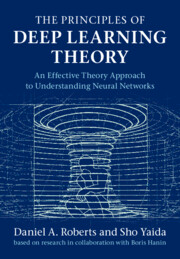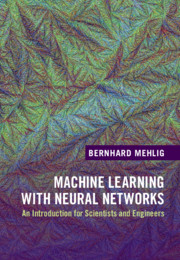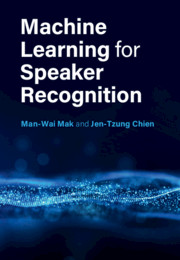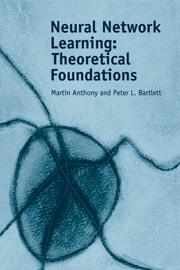The Principles of Deep Learning Theory
An Effective Theory Approach to Understanding Neural Networks
$79.99 (C)
- Authors:
- Daniel A. Roberts, Massachusetts Institute of Technology
- Sho Yaida, Meta AI
- Date Published: May 2022
- availability: Available
- format: Hardback
- isbn: 9781316519332
$
79.99
(C)
Hardback
Other available formats:
eBook
Looking for an examination copy?
If you are interested in the title for your course we can consider offering an examination copy. To register your interest please contact collegesales@cambridge.org providing details of the course you are teaching.
-
This textbook establishes a theoretical framework for understanding deep learning models of practical relevance. With an approach that borrows from theoretical physics, Roberts and Yaida provide clear and pedagogical explanations of how realistic deep neural networks actually work. To make results from the theoretical forefront accessible, the authors eschew the subject's traditional emphasis on intimidating formality without sacrificing accuracy. Straightforward and approachable, this volume balances detailed first-principle derivations of novel results with insight and intuition for theorists and practitioners alike. This self-contained textbook is ideal for students and researchers interested in artificial intelligence with minimal prerequisites of linear algebra, calculus, and informal probability theory, and it can easily fill a semester-long course on deep learning theory. For the first time, the exciting practical advances in modern artificial intelligence capabilities can be matched with a set of effective principles, providing a timeless blueprint for theoretical research in deep learning.
Read more- Detailed step-by-step explanations for all equations and clear exposition of both old and new concepts in deep learning theory make the book accessible to readers with a minimal prerequisite of linear algebra, calculus, and informal probability theory
- Many novel results that appear for the first time in the literature, taking readers to the forefront of deep learning theory
- Provides a unique approach that bridges deep learning and theoretical physics, demonstrating to the ML community how a theoretical physics approach can be useful, while also teaching techniques that are valuable for theoretical physicists
Reviews & endorsements
'In the history of science and technology, the engineering artifact often comes first: the telescope, the steam engine, digital communication. The theory that explains its function and its limitations often appears later: the laws of refraction, thermodynamics, and information theory. With the emergence of deep learning, AI-powered engineering wonders have entered our lives — but our theoretical understanding of the power and limits of deep learning is still partial. This is one of the first books devoted to the theory of deep learning, and lays out the methods and results from recent theoretical approaches in a coherent manner.' Yann LeCun, New York University and Chief AI Scientist at Meta
See more reviews'For a physicist, it is very interesting to see deep learning approached from the point of view of statistical physics. This book provides a fascinating perspective on a topic of increasing importance in the modern world.' Edward Witten, Institute for Advanced Study
'This is an important book that contributes big, unexpected new ideas for unraveling the mystery of deep learning’s effectiveness, in unusually clear prose. I hope it will be read and debated by experts in all the relevant disciplines.' Scott Aaronson, University of Texas at Austin
'It is not an exaggeration to say that the world is being revolutionized by deep learning methods for AI. But why do these deep networks work? This book offers an approach to this problem through the sophisticated tools of statistical physics and the renormalization group. The authors provide an elegant guided tour of these methods, interesting for experts and non-experts alike. They write with clarity and even moments of humor. Their results, many presented here for the first time, are the first steps in what promises to be a rich research program, combining theoretical depth with practical consequences.' William Bialek, Princeton University
'This book’s physics-trained authors have made a cool discovery, that feature learning depends critically on the ratio of depth to width in the neural net.' Gilbert Strang, Massachusetts Institute of Technology
'An excellent resource for graduate students focusing on neural networks and machine learning … Highly recommended.' J. Brzezinski, Choice
Customer reviews
Not yet reviewed
Be the first to review
Review was not posted due to profanity
×Product details
- Date Published: May 2022
- format: Hardback
- isbn: 9781316519332
- length: 472 pages
- dimensions: 261 x 184 x 26 mm
- weight: 1.06kg
- availability: Available
Table of Contents
Preface
0. Initialization
1. Pretraining
2. Neural networks
3. Effective theory of deep linear networks at initialization
4. RG flow of preactivations
5. Effective theory of preactivations at initializations
6. Bayesian learning
7. Gradient-based learning
8. RG flow of the neural tangent kernel
9. Effective theory of the NTK at initialization
10. Kernel learning
11. Representation learning
∞. The end of training
ε. Epilogue
A. Information in deep learning
B. Residual learning
References
Index.-
General Resources
Find resources associated with this title
Type Name Unlocked * Format Size Showing of
This title is supported by one or more locked resources. Access to locked resources is granted exclusively by Cambridge University Press to instructors whose faculty status has been verified. To gain access to locked resources, instructors should sign in to or register for a Cambridge user account.
Please use locked resources responsibly and exercise your professional discretion when choosing how you share these materials with your students. Other instructors may wish to use locked resources for assessment purposes and their usefulness is undermined when the source files (for example, solution manuals or test banks) are shared online or via social networks.
Supplementary resources are subject to copyright. Instructors are permitted to view, print or download these resources for use in their teaching, but may not change them or use them for commercial gain.
If you are having problems accessing these resources please contact lecturers@cambridge.org.
Media coverage of the book courtsey of SiliconANGLE
Sorry, this resource is locked
Please register or sign in to request access. If you are having problems accessing these resources please email lecturers@cambridge.org
Register Sign in» Proceed
You are now leaving the Cambridge University Press website. Your eBook purchase and download will be completed by our partner www.ebooks.com. Please see the permission section of the www.ebooks.com catalogue page for details of the print & copy limits on our eBooks.
Continue ×Are you sure you want to delete your account?
This cannot be undone.
Thank you for your feedback which will help us improve our service.
If you requested a response, we will make sure to get back to you shortly.
×




